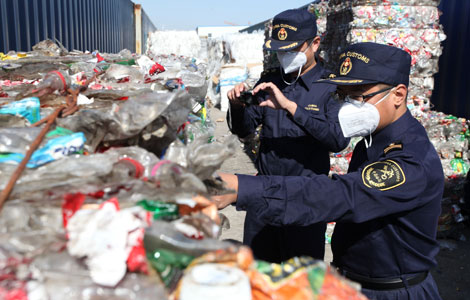Nation puts geospatial data system on the map
Updated: 2013-10-18 08:10
By Wang Qian in Chengdu (China Daily USA)
|
||||||||
China has established a national emergency geospatial data system to provide first-responders with detailed maps within two hours after a disaster, a senior official said.
At the Chengdu Forum on United Nations Global Geospatial Information Management in the capital of Sichuan province on Tuesday, government leaders and prominent geologists and land surveyors discussed how any effective disaster response starts with a map.
"In fighting with disasters such as earthquakes and mudslides, providing timely mapping support for affected regions is crucial," said Xu Deming, director of the National Administration of Surveying, Mapping and Geoinformation.
The national geospatial data system was established after April 20, when a magnitude-7.0 earthquake rocked Ya'an, Sichuan province. Only two hours after the quake, the National Administration of Surveying, Mapping and Geoinformation produced its first detailed map of the region. That set in motion a wave of support for the national agency from the central government.
By comparison, it took nearly nine hours for a map to be produced after the 2008 Wenchuan earthquake, which means mapping technology at the national agency has vastly improved.
At the three-day forum, which runs through Thursday, Xu said the first 72 hours after a disaster are crucial for rescuers in the search for lives. With the help of the national emergency geospatial data system, he said, loss of lives and economic losses could be held to a minimum.
Besides satellites, unmanned planes and surveying instruments, the data system uses Map World (the Chinese version of Google Earth), an emergency support platform to provide policymakers with disaster assessments as well as recovery and post-disaster planning suggestions and the National Fundamental Geographic Information System, said Li Pengde, deputy director of the national mapping agency.
"The system will provide timely and reliable mapping services anywhere in the country after disasters," Li said.
Wu Hongbo, under-secretary-general for UN economic and social affairs, said China is making great strides in emergency mapping and "taking a leading position in this sector of the world".
"In the first hours after the Wenchuan earthquake, I remember that some rescuers didn't know where they were or where to go. China has learned its lesson," Wu said.
After the Wenchuan earthquake, China released the National Emergency Mapping Action Plan in March 2009, which defined the responsibilities and requirements for national, provincial and regional surveying and mapping departments. In January 2012, China launched a high-resolution imaging satellite, called the ZY-3, to be used in not only monitoring the nation's land use and ecology, but also to be used in urban planning and disaster management.
But Liu Dake, deputy director of the geoinformation and mapping department under the national mapping agency, said there is still room for improvement. Liu said an emergency airspace coordination system should be established to deploy unmanned planes to take photos of disaster-hit regions.
China's air force controls the national airspace and allots only 20 percent of airspace for civil aviation, making it hard for nonmilitary flights to be approved quickly, disaster management experts said.
China was heavily affected by natural disasters in 2012, according to the Ministry of Civil Affairs, with about 290 million people affected and 1,530 deaths.
wangqian@chinadaily.com.cn
(China Daily USA 10/18/2013 page4)
Most Viewed
Editor's Picks

|

|

|

|

|

|
Today's Top News
US not budging on its arms restrictions on China
China's GDP rises 7.8% in Q3
China warns of emerging markets' slowing demand
Roche boosted by strong drug sales in US, China
IBM's China-driven slump sparks executive shakeup
Can cranberries catch on in China?
Asia-Pacific pays executives world's highest salaries
US debt deal a temporary fix
US Weekly

|

|













